Today's NFL game is won or lost based on your team’s passing game. While a handful of teams make it to the playoffs each year with suboptimal quarterback play and even sometimes win the Super Bowl, having good quarterback play remains the most important factor towards winning – a major revelation and a shock to us all.
Two factors play a part in defending the pass game – the pass-rush and coverage of the pass. While pundits will argue which is more important, our fantastic analytics team has done an excellent job mining PFF’s grades and data from the past 12 seasons to determine which correlates more to wins.
The answer is coverage.
Of the 12 playoff teams, eight had a top 12 graded coverage unit and when looking at the four other teams that failed to make it to the playoffs, the Ravens, Chargers and Seahawks all were nine-win teams and essentially a win away from an appearance.
Of course all coverage isn’t created equally and defensive coordinators all deploy different schemes in order to defend against the pass. League wide, teams tend to stick to Cover-1 (man coverage with a single-high safety) and Cover-3 (three deep players covering a third of the field with four underneath defenders covering a zone). These two coverage schemes accounted for a whopping 61.2 percent of all dropbacks excluding spikes in 2017.
Each scheme requires players to execute an assignment and while those assignments vary depending on the personnel on the field, the position of the coverage player and the scheme in which the player plays in, there are general buckets the players can fit into.
In this article, we’ll look at the prototypes of the defensive backs in today’s NFL game and who the standard is at the role along with who might be ready to take the mantel.
Press Man CB – Xavier Rhodes
The press man cornerback role is a difficult one as a loss at the line of scrimmage usually results is a sizeable gain for the offense. The job of the press man corner also often results in the player shadowing the opponent’s top receiver to either side of the formation and less often into the slot as well. Not many cornerbacks are talented enough to earn this role but Patrick Peterson has been a shining example of this for years. The press man cornerback will essentially try to jam or redirect the receiver at the snap and then mirror his route in order to cover the opponent. Typically, when the cornerback has a good jam or redirect at the line of scrimmage, the quarterback will look elsewhere to throw the ball. That’s why Peterson is used to shadow No. 1 receivers so often, his ability to shut down his opponent so quickly in the pass game forces the quarterback to look to his lesser options.
While Peterson had consistently been one of the best cornerbacks in the press man role but his play has dropped off in recent seasons. Xavier Rhodes has risen to the top of the league as he’s allowed just 13 catches on 42 targets for 176 yards while allowing zero touchdowns with two interceptions over the past two seasons when in press man. Rhodes is tasked with shadowing the opposing team's top wide receiver, though not as much as Peterson was in his prime, but he’s done so with more effectiveness. While Rhodes doesn’t grade as one of the best cornerbacks in the NFL because of his role resulting in being one of the leaders in penalties against, his assignments week in and week out are some of the most difficult in the NFL. He helps lead the Vikings defense and helps them operate at an elite level.
Up-and-Coming: Casey Hayward, Marshon Lattimore, Tre’Davious White, Kyle Fuller
Off Man/Deep Zone CB – Richard Sherman
The off-man/deep zone cornerback is much more prevalent in the game as the role isn’t nearly as difficult. It allows the defensive back to read and react – reading the quarterback’s eyes, seeing the play unfold and reacting accordingly. Being able to see the play unfold allows the cornerback to recognize whether or not his man or side of the field will be targeted and allows the ability to not have to expend energy to cover the route like he would if targeted. That isn’t to say the player can take the play off, it’s just easier physically and mentally on non-targeted plays when playing off-man/deep zone than it is when having to jam a receiver and match his route all the while.
Since the off-man/deep zone role is used so frequently in the NFL, being in the upper echelon of cornerbacks in this role has serious benefits for the defense. Whether needing to drive quickly on underneath routes or turn and flip hips to match with deep routes, the cornerback that can do both can effectively shut down an entire half of the field. No one has personified this better over the years than Richard Sherman. While he’s coming off a major injury needing surgery on both Achilles, what Sherman was able to do in Seattle’s Cover-3 system is Hall of Fame worthy. Arguably the best cornerback in the NFL at defending the ‘go' route, Sherman is the epitomie of a shutdown cornerback.
Over the course of his career, Sherman has allowed a paltry 53.0 passer rating when targeted, intercepting 34 passes with 62 pass defenses and just a mere 17 touchdowns. He’s allowed less than 48.6 percent of his targets to be caught in every season except one when it was just 51.8. Since entering the league in 2011, Sherman has lead the NFL in cover snaps per target twice and ranked third another season. Most impressively, his coverage snaps per reception allowed has ranked him first or second in every season except his rookie debut and his injury-shortened 2017 campaign where he ranked sixth.
Up-and-Coming: A.J. Bouye, Jalen Ramsey, William Jackson III
Slot CB – Chris Harris Jr.
Our analytics crew has hammered home the importance of the slot cornerback this offseason so I’ll hold off on that point here and strictly talk about the role of the position (but seriously, read the articles diving deep into the position, it’ll be worth it). Teams run '11' personnel (1 HB, 1 TE, 3 WR) the most of any package in the NFL – about 58 percent of the time – with the next closest personnel package being '12' personnel (1 HB, 2 TE, 2 WR) at a mere 19 percent. To combat this league wide, teams deployed at least five defensive backs nearly 63 percent of the time. Almost always, this fifth defensive back comes in the form of a slot cornerback whose job is to cover the slot wide receiver.
Traditionally, offenses have a smaller, shiftier receiver manning the slot in order to quickly get open and the defense’s answer to that is a cornerback that is typically small and shifty. Of course being able to jam the wide receiver at the line of scrimmage is a good initial method but with the ability to line up off the LOS, this isn’t always possible. Often times, the best slot cornerbacks are some of the best tacklers in the game, usually excelling in run defense and as pass-rushers. Most importantly though, being able to shutdown the receiver out of the slot adds tremendous value and that reigns supreme.
In what should not be a surprise to anyone, Chris Harris Jr. has been the gold standard of slot cornerbacks. He isn’t just relegated to the slot as he’ll start at outside cornerback in base packages and move inside when the extra defensive backs enter the game. Harris is excellent in both the slot and outside but best and most valuable when manning inside receivers. Allowing a reception once every 16.3 cover snaps in 2017 ranked second best in the NFL as did his 9.3 cover snaps per target. In fact, in every season besides his rookie year, Harris has ranked in the top 10 in both metrics usually ranking top three in either of them.
Up-and-Coming: Kendall Fuller, Desmond King, Byron Jones
Big Nickel/Dime LB – Kam Chancellor
The big nickel/dime linebacker is a more recent development in the NFL in order for teams to combat to growing usage of multiple tight ends in the pass game as well as offenses trotting out bigger and more physical slot receivers. The biggest matchup nightmare in the NFL is a healthy Rob Gronkowski who is too agile and quick for most linebackers while being much too tall and large for most cornerbacks and safeties. Enter into the equation, someone with the movement skills of a cornerback but the size of a linebacker and you have yourself a big nickel/dime LB. While there aren’t many in the NFL today, having one on your team can be the difference in any game against forward-thinking teams like the Patriots.
Another advantage of having this type of player is being effective as a pass-rusher and against the run. While the NFL is still trending upwards in how often pass plays are called and teams are getting smarter about utilizing multiple tight ends to force defenses into base packages, having a player to defend the run in these situations but also cover is vital. We at PFF advocated for Florida State safety Derwin James to be drafted in the top five because of this very fact, but he fell to the Chargers at 17 so the NFL is still a ways off from fully understanding the importance of the position.
The gold standard of the position over the past half-decade has been Kam Chancellor with his ability to cover slot receivers and tight ends effectively but also grade as one of the best run defenders from the safety position in the NFL. He’s not going to be a threat as a pass-rusher generating just 13 total pressures in his career, but his dual usage in pass coverage and run defense is what the position embodies. Chancellor will have down games as the role to transition from covering slot receivers to tight ends to filling gaps in run defense against all personnel is a tough one and he was a key reason for Seattle’s Super Bowl runs in 2013 and 2014.
Up-and-Coming: Derwin James (if he continues to show the type of play he did at fsu)
Single-High Safety – Earl Thomas
This position is rather straight-forward but few players in the NFL can execute it at a consistently high level. NFL coaches absolutely covet players that can play this role as it allows defenses to play with 10 defenders closer to the line of scrimmage where most of the action happens on a play. If you have a player that has the speed, range and instincts to cover the entire field quickly, it frees up everyone else on the field. Being effective as a single-high safety isn’t all about athleticism but more so about being able to diagnose the play in front of you and quickly react to that read.
Former Baltimore Ravens safety Ed Reed epitomized this role for nearly a decade in the NFL and he passed the torch to Earl Thomas. Thomas has been quite the hot topic in recent days because of his contract holdout but Seattle would be wise to come to a resolution with the three-time All-Pro. Nothing shows Thomas’ importance better than when he was injured in 2016 and 2017 and how drastic Seattle’s defense took a step back.
On all pass plays across the league, when Thomas was not on the field for the Seahawks, opposing offenses averaged 0.07 expected points added (EPA) per play. With Thomas on the field, opposing offenses actually averaged -0.04 EPA, showcasing just how important he is to not just the back end of the defense, but how important he is for the entire unit across the field.
What Thomas has been able to provide Seattle since entering the NFL, and what is quantifiable when he misses time, has been at a near elite level.
Up-and-coming: Kevin Byard, Marcus Williams, Lamarcus Joyner
Two-High Safety – Landon Collins
The main difference between the single-high safety and the two-high safety is that the needed athleticism, speed and range isn’t nearly as significant for the two-high safety. The two-high safety can get away with a lesser athletic profile but still needs to display high-level instincts, discipline and the ability to read his keys correctly while also reacting quickly. Reading the quarterback’s eyes and recognizing when danger comes to his zone is vital as opposed to allowing the play unfold in front of him. Needing to play half the field versus the full field allows for less athleticism but doesn’t allow for slow recognition and reaction of the play.
Though his rookie season was one to forget, Landon Collins has been fantastic in this role for the New York Giants the past two seasons. Collins doesn’t have the elite athleticism you look for in the single-high safety but he brings those high-level instincts and the ability to shut down a deep half of the field. Collins dominated in his one season of college grading and though it took a year to acclimate to NFL speed and play, has also done so in the NFL.
Up-and-coming: Adrian Amos, Karl Joseph
Versatile/Do-Everything Safety – Harrison Smith
This needs a better name. Jack of all trades? This is a player that our Steve Palazzolo pegged as the “Woodson” after future Hall of Famer Charles Woodson. Perhaps with the passing of the torch to Harrison Smith, a name change of the position is due to happen. The ‘do-everything' safety position is needed to cover single-high, two-high, roam the box, take on the big nickel/dime LB role, while also lining up on the line of scrimmage and blitzing the quarterback. Ask Smith to perform any role and he's able to execute it.
Smith embodies this description aptly. He’s a player that opposing quarterbacks need to account for on every snap of the game because he can literally line up anywhere on the field except perhaps lining up on the defensive line. He was able to spend 112 snaps as an edge linebacker, 227 snaps at off-ball linebacker, 34 snap at outside cornerback, 153 snaps at slot corner, 163 snaps at strong safety and 414 snaps as a deep safety and turn it into the best season PFF has ever seen from the safety position. He’s extremely effective rushing the quarterback with a 28.6 pass-rushing productivity while also maintaining top grades in run defense and coverage, and a sure-tackler with a tackling efficiency of 17.2.
Smith simply had no equal at the safety position last year and while regression is bound to happen, his play is the gold standard for the do-everything role.
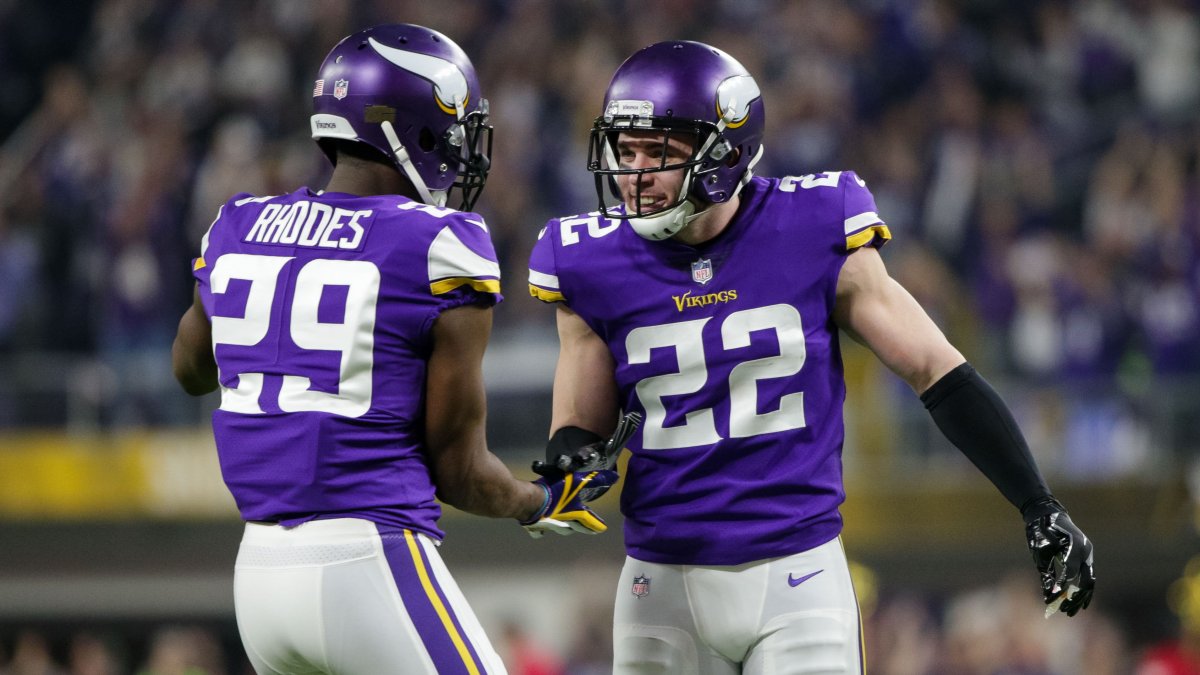
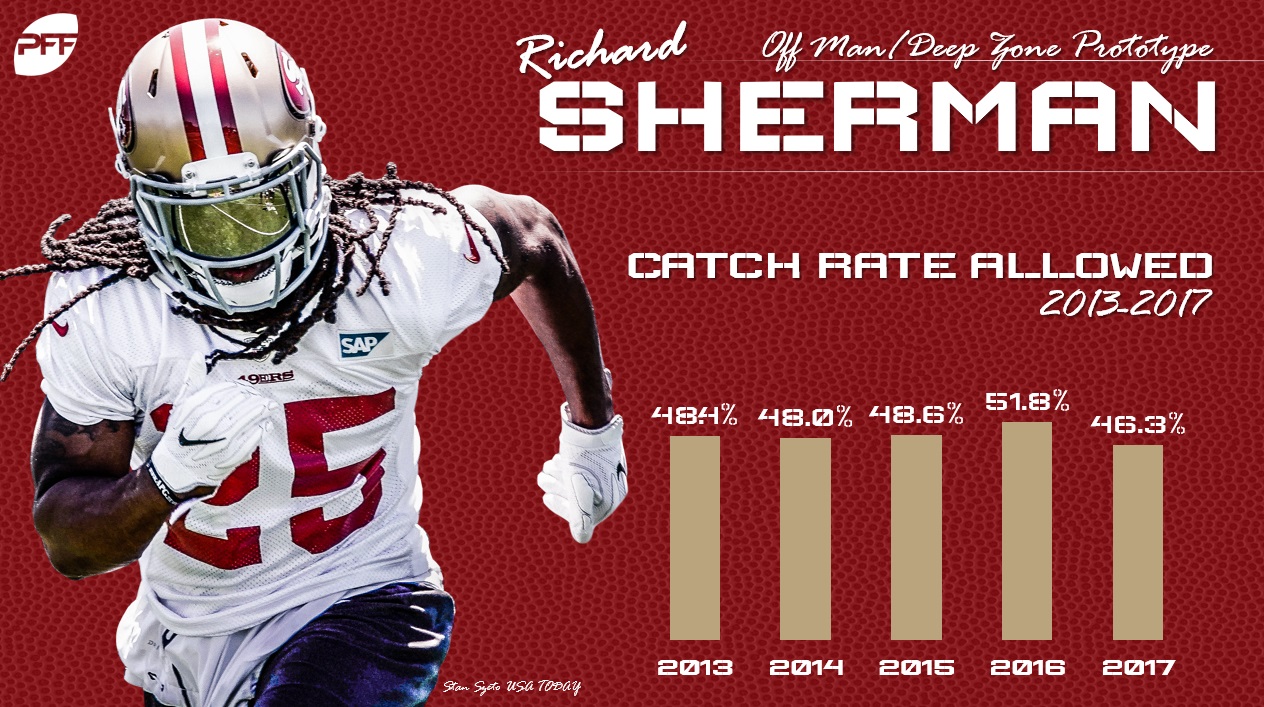
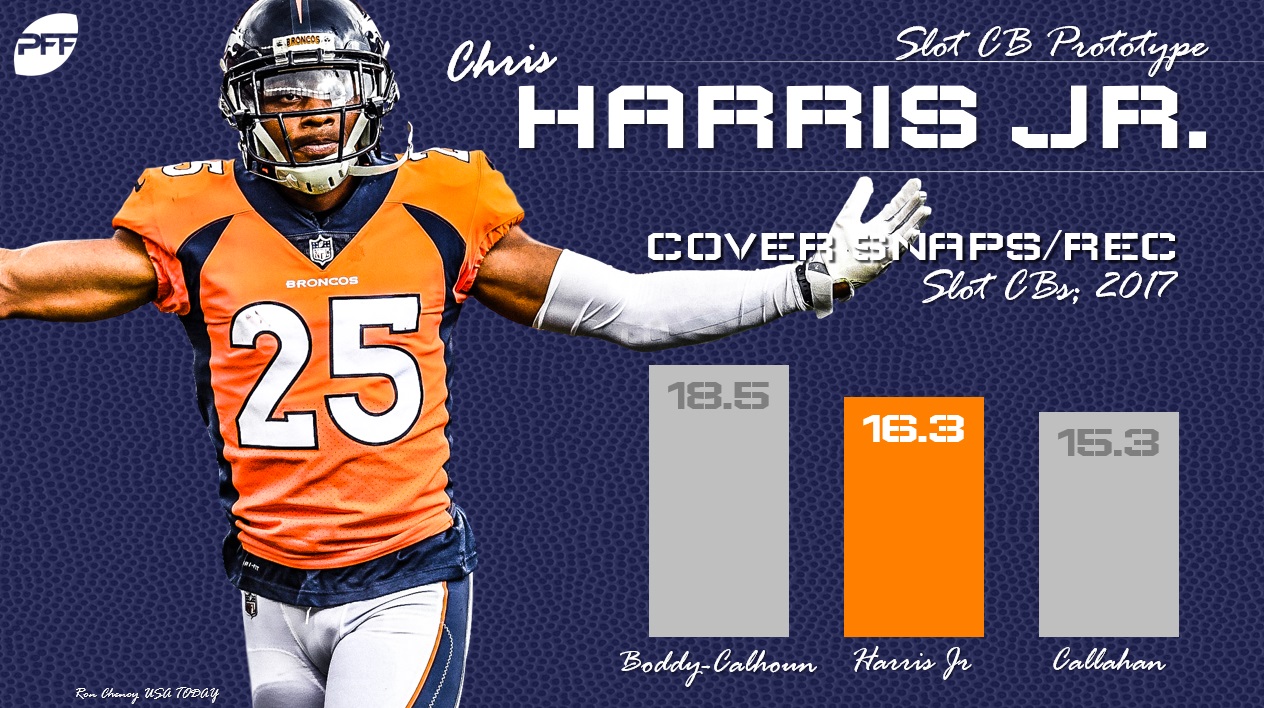
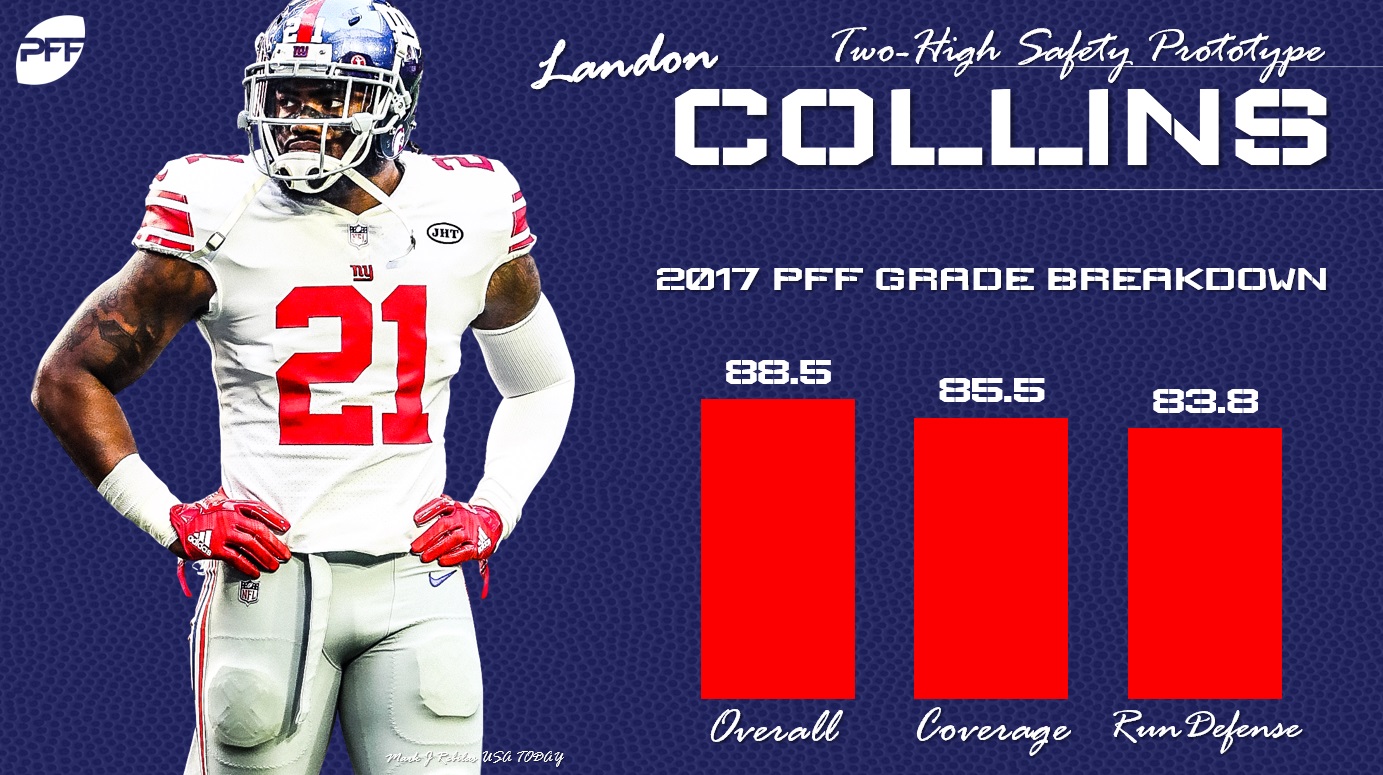
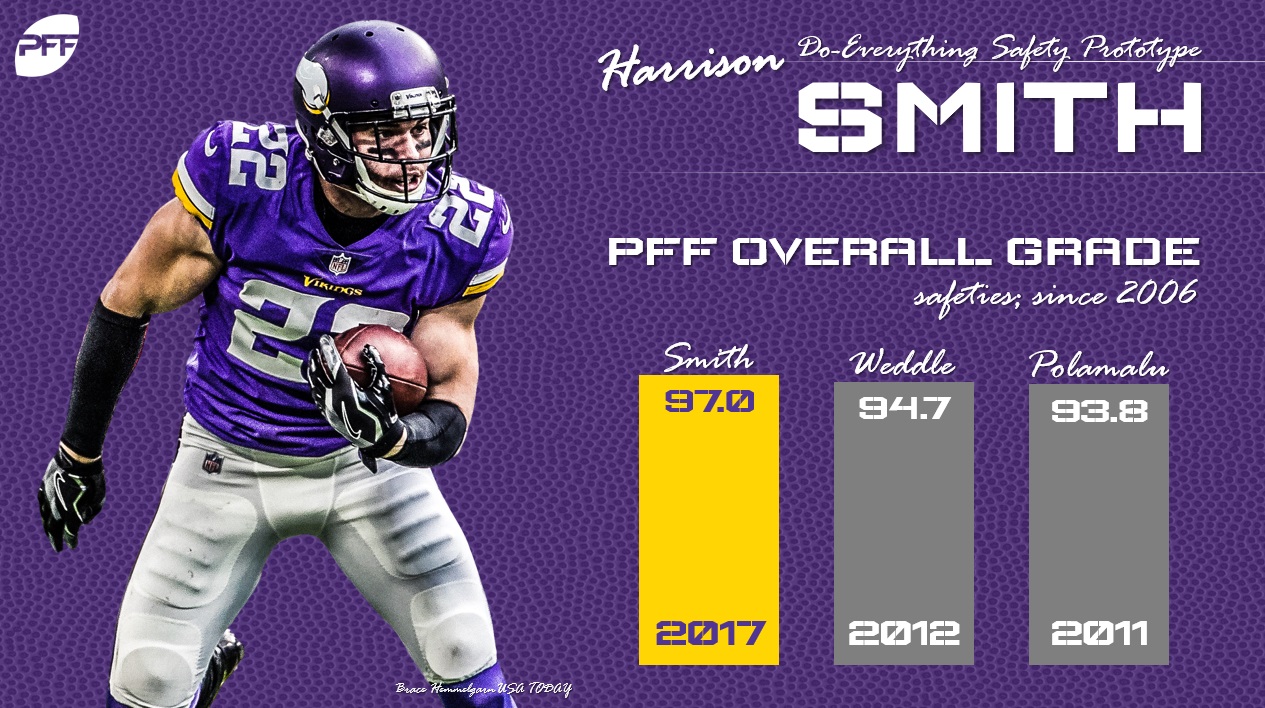


 © 2025 PFF - all rights reserved.
© 2025 PFF - all rights reserved.